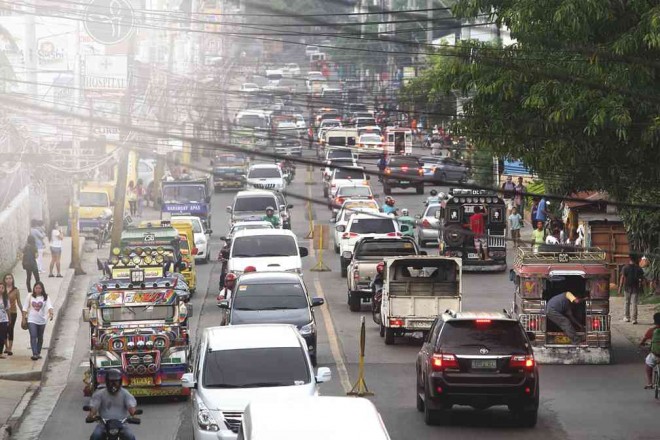A way out of traffic: No left turns?

THE CEBU City government turns to a “no-left-turn” policy on 15 intersections and access roads to solve the daily gridlock that commuters endure. TONEE DESPOJO/ CEBU DAILY NEWS/ Citom
For a bustling metropolis besieged daily by horrific traffic, officials of Cebu City are finding that the “no-left-turn” policy is pointing at the right way to ease road congestion.
In particular, they claim that the policy is working along the city’s gateway to the northern corridor—the 10-kilometer Banilad-Talamban (Ban-Tal) area, Gen. Maxilom Avenue and Salinas Drive in Barangay Lahug, especially during peak hours.
But motorists are grumbling because it means traveling several meters more in bumper-to-bumper traffic to make it to designated U-turn slots and head to their destinations.
“We disregard individual inconvenience for the benefit of the majority,” said Raffy Yap, executive director of the City Traffic Operations Management.
Experiment
Article continues after this advertisementThe no-left-turn policy started as an experiment last year to address heavy traffic along Gen. Mariano Cuenco Avenue, known as the Ban-Tal area.
Article continues after this advertisementSubdivisions, malls, schools and several business establishments are found in the area.
Traffic is usually heavy from 6 to 8 a.m. and from 5 to 7 p.m.
The road scheme, whose implementation was ordered by Mayor Michael Rama on June 30, 2014, affects 15 intersections and access roads leading to subdivisions and commercial establishments. Violators face a fine of P500.
At least 20 traffic marshals were deployed to assist motorists, while orange metal barriers were installed on affected areas to warn motorists of the new traffic prohibition.
It was confusion, rather than order, which marred the first days of the scheme. Motorists did not know where to go, resulting in gridlocks.
“What we did was more of a philosophy rather than the standard operating procedure, which required that we should first disseminate information. But the mayor deemed that the traffic situation was already a disaster,” Yap said.
Longer routes
Subdivisions dwellers complained of longer routes to take to get home. Those bound for Sto. Niño Village from Barangay Talamban had to travel 100 meters more to get to the nearest 
Eventually, the motorists have gotten used to the new scheme. The traffic has eventually improved to a certain degree.
Enrique Abellana, president of the Ma. Luisa Estate Park Homeowners Association, said the problem of congestion had not been solved.
“There should be a strict enforcement (of traffic rules) because jeepneys disregard rules on no loading and unloading, which causes congestion. These jeepney drivers should be fined,” Abellana said.
For seven months, Yap said the policy had been revised at least five times and was still being fine-tuned.
And there are two more road sections where left turns are not allowed.
Motorists bound for F. Ramos Street cannot turn left from General Maxilom Avenue, but must go to the Fuente Osmeña Rotunda. Those exiting from Jose Maria del Mar Street at the Cebu IT Park cannot turn left to Salinas Drive in Lahug but must pass through W. Geonzon Street, or about two blocks away.
No scientific studies
Yap has insisted on improved traffic in areas where left turns are not allowed, but he has no time-and-motion studies to support his claims. “What we know is just based on the reports that we are getting from motorists,” he said.
Councilor Alvin Arcilla, a former chair of Barangay Talamban, called for a scientific study to guide traffic planners on how to effectively solve the worsening congestion. The scheme’s success is not even supported by vehicle count, he said.
Moreover, the policy merely created choke points in the U-turn slots, Arcilla said.
“If you live in that (Ban-Tal) area, you will notice that every now and then, they are changing the traffic scheme. They keep changing it without any basis. There should be a proper data in the decision-making,” he said.
Bunny Pages, who was appointed by Mayor Rama to head the Ban-Tal Task Force, acknowledged that the city’s experimentation did not portray “the whole picture.”
“We need experts to map the whole thing out. We need assistance,” said Pages, who owns a private school in the area.
He has asked the city government to apply “pressure” on the Department of Public Works and Highways to rush the completion of a P150-million road widening project in Ban-Tal.
The project involves a 1.6-km stretch to be extended from four to eight lanes, from the Mahiga Creek to the Cabancalan Road. It started on February 13, 2013, and was supposed to be completed in less than a year. Delays in right-of-way acquisition have stalled the project.